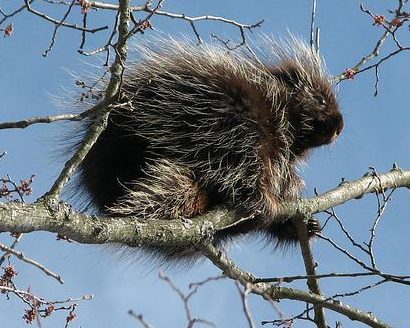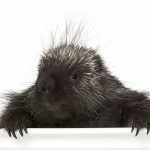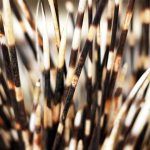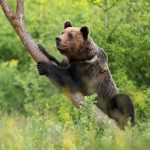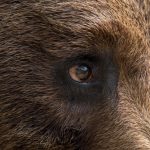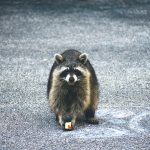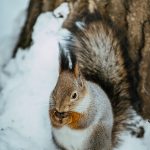The porcupine has alternating black and white markings on its body. When the porcupine’s quills are raised, it reveals a white stripe running down its back, giving it the appearance of a skunk. The porcupine’s body and coarse hair are a dark brown or black color. Both this and the raising of the sharp quills serve to discourage potential predators.

Porcupines, like most other rodents, do not hibernate during the winter. Even though they are active throughout the year, they spend most of their time hiding out in their dens when the weather is poor. Porcupines can forage for food or take shelter in trees during the winter months when the temperatures are milder.
Porcupines are typically nocturnal animals; however, during the winter months, they frequently change their routines to avoid foraging when the temperature is below freezing.
There are two distinct families that porcupines are a part of the Hystricidae and the Erethizontidae.
- The first type also referred to as porcupines from the Old World, can be found in Europe, Africa, and Asia.
- The second, also known as New World porcupines, can be found living in forests and other wooded areas across the continents of North America, South America, and the northern regions of both continents.

Where do porcupines go in winter?
Dens, burrows, hollow trees, or caves are some of the common habitations for porcupines. They spend the majority of their time during the winter months inside the den, emerging only to forage for food when the conditions are favorable.
However, even if you are unable to see porcupines during the winter, they do not travel anywhere. They do not leave their territory, but occasionally they will go to the territory of another porcupine that is nearby to increase their chances of surviving by sharing the den with it.
When the temperatures begin to rise in the spring, New World porcupines that have been spending the winter together in the same den will disperse and go back to their respective home ranges.

Do Porcupines Migrate?
Winter is not a time for migration for porcupines. Their diet is comparable to that of beavers, and during the winter months, the inner bark of trees is their primary source of nutrition. Porcupines that live on land do not find it necessary to bury food supplies. Instead, they leave their dens and travel to a tree in the area to eat.
These rodents are common animals. Their ability to travel is restricted during the winter months, particularly when the weather is particularly severe. Porcupines can return to the same tree multiple times over the course of days or even weeks, always taking the same, well-worn path across the snow. They remain in their dens during the days with the lowest temperatures and can go for several days without eating.
It’s possible that arboreal porcupines will have to emerge from their burrows in order to find food. Although they raise their young in trees, porcupines typically select different kinds of trees for food than they do for their homes.
The breeding season for porcupines in North America begins in early winter. Like most rodents, porcupines are territorial animals. However, they are not social creatures and spend most of their lives by themselves. When females reproduce, they establish territories for themselves that do not intersect with those of other females. On the other hand, the territory that a male occupies is likely to overlap with that of multiple females.

Where do porcupines go at night?
They go out hunting for food when the sun goes down. Porcupines from the New World spend their time in the branches of trees, while porcupines from the Old World remain on the ground. Porcupines aren’t known for their outgoing nature.
What do porcupines do in the summer?
Their diet adapts to the different seasons. They focus their diet primarily on evergreen needles and the inner bark of trees during the winter months. Because of this, they frequently feed heavily on a single tree, which can result in the tree’s demise. Porcupines change their diet to consist of berries, seeds, grasses, leaves, roots, and stems during the spring and summer months.
Can porcupines live in cold weather?
They can maintain a consistent core temperature throughout the winter months by using their quills and guard hair as an insulating layer. They are ultimately able to make it through the winter by consuming a lot of fat and not moving around very much. Actually, approximately half of the porcupine’s total weight in the autumn was composed of fat.
Are porcupines active during the winter months?
They are nocturnal, meaning that they are most active at night; during the day, they will frequently rest in trees. They do not engage in hibernation but instead sleep in and remain near their dens during the winter months. Because of the robust nature of its defense, the porcupine is able to lead a solitary existence, in contrast to the majority of herbivores, which are forced to travel in groups known as flocks or herds.
How do porcupines damage trees?
Porcupines are nocturnal. They spend a significant amount of time perched high up in the branches of trees. Porcupines cause damage to trees by gnawing through the bark in order to consume the inner bark during the winter months. They favor trees made of softer woods. They do not typically bring down trees.
Why do porcupines climb in trees?
This is because most predators are unable to climb. Porcupines, like many other mammals, are well suited to a life in the trees. They can scale trees thanks to the sharp, curved claws that are embedded in their sturdy paws. Their feet are textured, which allows them to get a better grip on the bark of tree trunks and branches. They also have a tail that assists them in maintaining their balance while climbing trees.

Do porcupines mate for life?
They live in small family groups with their offspring and are monogamous, with the pair typically remaining together for the rest of their lives. They are mostly active at night and spend the day dozing off inside their burrows.
What is a group of porcupines called?
And then there are squirrels, which are aptly referred to as a “scurry” in the English language. A group of porcupines is referred to as a “prickle,” which is another wonderful example of a collective noun. This noun describes the group of porcupines. A group of bats can be referred to as either a “colony” or, more accurately, a “cloud.”
What season are porcupines the most active?
Porcupines are normally timid and solitary animals, which means it is unlikely that you will find one near your home. However, during the winter months, they may den in small groups with other porcupines. They are active throughout the year but are rarely seen because they are most active at night and prefer to hide high in a tree or in a den during the day. Although they are active, they are rarely seen because they are most active at night.
Where do porcupines spend most of their time during the day?
Most of the time, porcupines are nocturnal animals. During the day, they spend their time sleeping in underground burrows, hollow trees and logs, or crevices found in rocky areas. Although they are most frequently discovered in evergreen or coniferous forests, they have also been discovered in deciduous woodlands and among creosote in the deserts of North America.
What do porcupines prefer to eat?
Porcupines change their diet to consist of berries, seeds, grasses, leaves, roots, and stems during the spring and summer months. Porcupines at the National Zoo in the Smithsonian Institution are fed herbivore pellets in addition to a wide variety of fruits, vegetables, and greens. Corn on the cob is their favorite type of corn product to eat.
How far do porcupines’ quills go when they shoot?
They are unable to even shoot their quills a single inch. Instead of shooting their quills, porcupines use their tails to drive them into the flesh of their enemies. To be attacked by a porcupine’s quills, a predator needs to be in very close proximity to the animal.
Are porcupines aggressive?
The animal’s own body heat causes the barbs to swell, which causes them to penetrate the skin of the target even further. When an animal is struck in a vital area, there is a chance that it will pass away. The porcupine is not a hostile animal by any means. It won’t go on the offensive unless it feels threatened.
How long do captive porcupines live?
The average lifespan of a porcupine is very long. In the wild, they have a lifespan of ten to fifteen years, but in captivity, they can live for up to twenty years.

